B2B SaaS Marketing: How To Get Started

This article is useful if you are looking for help with a go-to-market strategy for B2B SaaS, or if you already have a B2B SaaS marketing strategy and you want some ideas on other areas you can be looking at. We’ve also written another article about B2B SaaS Lead Generation which you may find useful too.
Can we help with? Find out:
– B2B SEO Services for SaaS companies
– B2B PPC Services for SaaS companies
– B2B UX & Web Design Services for SaaS companies
What is B2B SaaS Marketing?
Founders of modern tech businesses have realised that SaaS is the best way of making money with very little overhead, therefore B2B SaaS marketing is now a thing.
A lot of SaaS businesses are essentially trying to build a self-serving product that users pay for on a monthly basis that’s easy to use.
The reality is slightly different, a lot of tech businesses have been around in different versions for a number of years, and the founders come from a variety of different backgrounds, some are ex-sales leaders, some CTOs and some university drop-ops with a big idea and some coding experience.
Marketing in these businesses can be tricky and it can help to self diagnose the type of technology business you are working in first.
Recognise your business model
Before you start thinking about go to market strategies or adjusting existing ones you need to review the type of business model you are working with. A lot of businesses call themselves SaaS but sometimes that’s not the reality.
Here’s a useful analogy from IBM explaining the differences in types of software business models. IAAS stands for Infrastructure as a service, PAAS means platform as a service and obviously SAAS stands for software as a service. We’ll be focusing on SAAS companies but it’s useful to see it in context.

There are lots of B2B tech companies that fall in between these 3 categories, but these are the 3 main types of businesses we see and work with when it comes to B2B SaaS Marketing.
The Pure B2B SaaS Business
The pure B2B SaaS tech business has a product that is hosted online (in the cloud) – it usually has some sort of low friction sign-up process and can be used a lot of the time by individuals as well as businesses – target the individual, get the business afterwards. Examples are Trello, MailChimp, Slack. You can use and download these tools for personal use and just by chance they are great for businesses too. This is happening more and more often as the lines between B2C and B2B are becoming more and more blurred.
Marketing like a B2C business means you have a larger audience and a greater potential for growth. Try and distil your B2B SaaS product down to the one problem it solves really well. Then ask yourself, is this a problem for an individual as well as a business?
Being a B2B SaaS marketer in this type of business requires you to help develop the product as much as market it.
Enterprise B2B software specialists
In these businesses, the buyer journey is pretty lengthy, it usually involves requesting a demo, some sort of pre-sales cycle and then custom setup or installation.
Enterprise B2B Software businesses will face competition by more disruptive SaaSy businesses and will be losing market share to them but usually only on a small scale.
These types of businesses tend to do better if they are serving enterprise-grade clients as their product becomes very sticky and it’s difficult to shift. The roots of the software are deep within a business. For example logistics software with lots of customisations in will not be easily replaced by a sign-up online system.
Enterprise B2B software will also have an army of professional or consultants who have made a living out of helping companies customise it. Salesforce is a great example of this type of business.
The Hybrid B2B Tech Business
The middleman. Stuck between knowing whether to go enterprise and more customised or whether to try and be more SaaSy and go after smaller businesses.
The hybrid B2B tech business is the one we come across the most. They serve SME and aspire to win larger clients as they develop and their product evolves.
Typically this is the company that is pivoting from being a service-based software company, providing specialist solutions to each client towards one platform that can be customised by clients themselves – therefore becoming a software as a service business.
It’s a tricky tight-rope being in this type of business as the CEO, CTO and Founders can switch between what they want the company to be, and what the company is now.
SaaS Marketing in a company transitioning between the two states means you really have to force your opinions and objections when required, as often you may be asked to market like a SaaS product but you don’t have the product to follow it up.
Lead Generation for B2B SaaS
B2B SaaS Lead Generation in a pure SaaS business normally skips the step of ‘speak to a human’. This means call to actions such as ‘Get in Touch’ or ‘Request a Demo’ are not where you are trying to drive people.
Instead, you will be wanting people to “Sign Up” or “Start Your Free Trial”. Because ideally, your SaaS product is set up so people can self-serve and go through a walkthrough of the product instead of having a sales rep give them a demonstration.
Sometimes companies have a combination of the two. One CTA that speaks to someone in sales or in customer success and one to get going without speaking to anyone. This is also a good way of addressing the difference in company profiles – you may want a different buyer journey for an enterprise client.
Enterprise clients are more used to considered sales journeys and there is still the elitist mentality that it feels nice to have someone spend more time of you. This is why most SaaS businesses tend to evolve their enterprise offering over time so they will hire more people to cover off this account management part.
3 Example B2B Website CTAs
We have pulled together 3 prime examples of some successful B2B SaaS websites to show how they are presenting CTAs to their website visitors.
1. Enterprise and Start-up Combo
Often B2B SaaS businesses will want to address a broad market. Unless you are specifically only targeting enterprise size businesses or small start-ups you will need to have slightly different buyer journeys. One for a considered approach and one for the quick starters who want to get stuck in.

2. Free Trial and Login
This is the classic SaaS setup on a website homepage. You either have a) customers landing on your website wanting to log in or b) new prospects wanting to find out more.
Buffer’s homepage has a very clear path for each visitor. It’s worth noting Buffer is a B2C and B2B tool so it has to address both types of customer. You can see they have the “Try Buffer for Business’ link in the top right.

3. Request a demo on Marketo.com
Although requesting a demo is usually designed for B2B companies that are not SaaS – it’s very common in businesses that are transitioning to a SaaS model, or they have a sales team already or if they are doing a lot of medium to large deals.
When a company is well established like Marketo they don’t need to do as much work to try and onboard new clients so they can get away with using the ‘request a demo’ call to action.
If your product is fairly complex and needs a lot of context to be explained correctly you may want to include this is a barrier to entry so that your leads get the best experience possible when viewing the software. Sometimes just letting the website explain it for you isn’t the right approach.
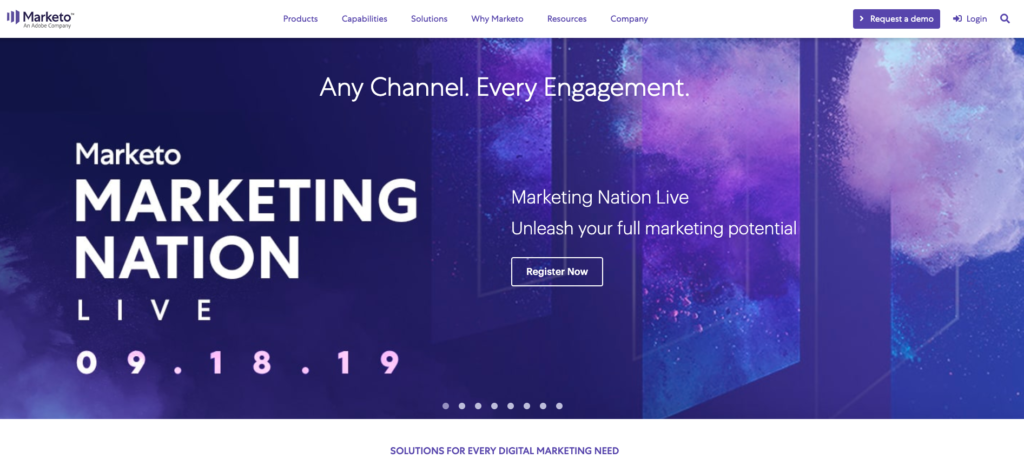
B2B SaaS Lead Generation Tactics
B2B SaaS lead generation strategies are very similar if not identical to normal B2B Lead Generation strategies. They are just slightly tweaked in most cases to point you towards a different call to action. Here are 5 tactics you can use (if you’re not already) for generating more B2B SaaS leads.
YouTube Marketing
YouTube Ads are a good way to catch your prospects attention while they are searching for useful video content. They are also good for retargeting campaigns.
You can also include a CTA (bottom left in this picture). YouTube Video Ads are also reasonably cheap in comparison to some other Paid channels like Search Ads.
YouTube is the 2nd most-visited website in existence, according to Alexa.
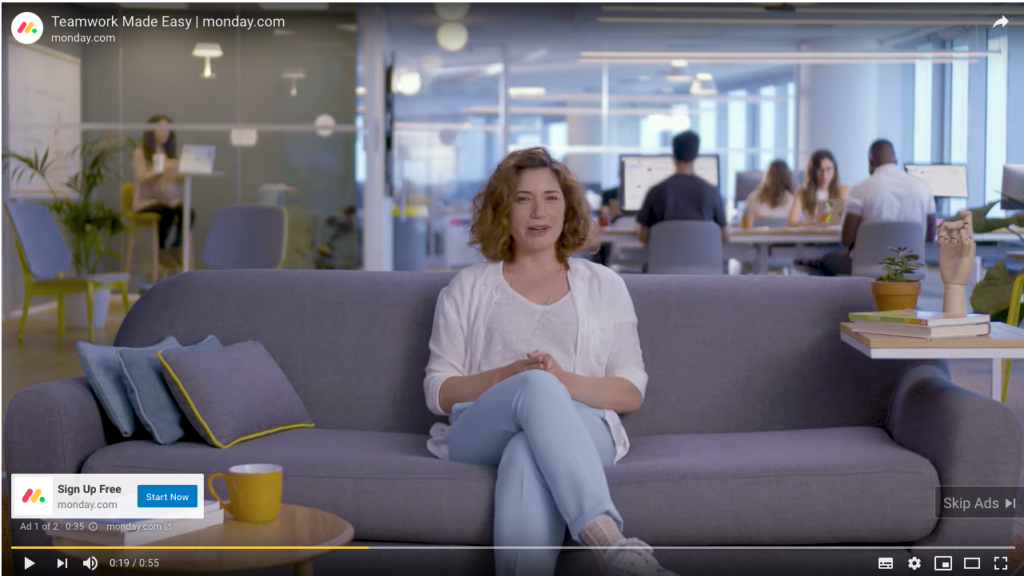
Podcast Advertising
Podcasting is bigger than ever, 50% of all US homes are podcast fans (Nielsen, Aug 2017). The audience is engaged and are often intently listening on their commutes or while they work out.
SquareSpace and MailChimp are two SaaS companies that have used podcasting ads on platforms such as Spotify to reach new audiences. You can use a company such as Midroll to find relevant podcasts for your audience.
Inbound Marketing
HubSpot invented the term Inbound Marketing, and now it’s the most common digital marketing strategy used by growing B2B SaaS businesses. We’ve written quite a bit about it in the past, we wrote a complete guide to Inbound Marketing which you may be interested to read too.
Inbound Marketing basically revolves around content marketing and SEO. The principle is that you attract people to your website by producing useful content around relevant keywords. For example, people searching for “how to manage projects better” would be interested in a product that could help them do this. So an article on “5 Ways to Manage Your Projects Better” is highly relevant to this searches intent.
A lot of B2B tech websites find their blog content can be the most viewed content on the website – even more than the homepage.
This type of marketing strategy also places you as a thought leader as you are adding value beyond just providing a piece software, you giving some free advice that people can take or leave. Another reason why Inbound Marketing is growing in popularity.
B2B SaaS start-up marketing tactics
If you are thinking of setting up, or in the process of setting up a SaaS business your marketing strategy kicks off before you finish making the product. You may also be looking for some lower-cost tactics for building your email list.
Your email list is probably your best marketing asset when you are starting a business. Grow your email list and you’ll grow your business.
Pre-launch marketing tactics can be a great way of building your email list before you have even done anything yet.
Growth Marketing, the lastest Buzzword
Growth marketing is a term that is becoming more and more popular in SaaS B2B businesses. Head of Growth & Growth Marketing Manager are now two very common job titles in growing tech businesses.
The reason growth marketing is a term that has arisen in the past few years is because of the understanding that marketing isn’t just about being given a product and then told to market it. Businesses realise that growing a tech business is more than just traditional marketing.
What is Growth Hacking?
Growth Hacking just means getting the biggest impact for the smallest cost. It’s a move away from the typical marketing channels to try and find new and innovative ways to grow a business without spending a lot of money. Just like a hacker would find a way of cheating a system, growth hacking is about growing a business without having to invest the normal amount of money you would have to.
Hacking is a bit too much of a contentious term for people to use in legitimate businesses so they tend to drop the hacking bit.
What does a Growth Hacker do?
A ‘Growth Hacker’ is someone who sees themselves as an expert in generating growth in a business for a low cost – and quickly. Although everyone describes it differently depending on how philosophical they are feeling.
In B2B SaaS marketing, it’s important to understand that your biggest tool for growth is the product you’re making. You should try to make the product you’re developing as shareable as possible – it should advertise itself – a Marketing person in a SaaS business is a traditional mindset – you should try to grow your business by making your product grow by itself.
Slack Marketing Strategy
Slack is now used by nearly every start-up I have ever encountered. Before it made it ‘big-time’ Slack applied a common start-up B2B SaaS marketing tactic – the limited release sign-up page.
Psychology plays its part. Scarcity is a principle of persuasion. Humans naturally are drawn towards things that are ‘rare’ or ‘scarce’. A limited release plays on this principle and at the same time builds your email marketing list before you have even started doing anything.
You can combine this type of landing page with some Paid Advertising to really increase the volume of traffic quite quickly and start building up your email list.

Building a software product for growth
A good example of growth marketing would be what Google did with Gmail when they started out in the 2004. They included a “sent with Gmail” link at the bottom of every email (Apple have copied this most recently with the Sent from my iPhone text). They also used a referral scheme or a “invite a friend” program – seen in the screenshot below.
This type of tactic fuels possible exponential growth because it is not reliant on in-house marketing it relies on word of mouth and what later was coined ‘Viral’ marketing. Or thinking about it another way it’s crowdsourcing your marketing.
This is taking a classic recommendation from the ‘real’ world into the digital one. The key is making it easy, and making the thing you are recommending worth it.

Sent from my iPhone
Apple didn’t pioneer this little trick but they certainly have put it to good use. What seems as like a handy little tool for the user to let people know they are on the move is actually a digital marketing tactic that has been around for decades.
I call this creating brand residue. It’s what is left behind when you a user interacts with your product and leaves a trace of your brand somewhere else for someone else to find. (Think reusable shopping bags).
Digital brand residue is the online version of putting a sticker on every lamp-post you walk past.
Creating brand residue in B2B SaaS products
This is done quite a lot in SaaS products where the free version has the logo on it but the paid version doesn’t. A lot of people engage in these practices but don’t really know the point of them.
Another example of creating this sort of effect is through content marketing.
As well as being great for SEO, content marketing can be a good way to get your brand name spread across the internet. So if you are thinking about link building strategies for SEO, also think how these can be combined – it’s basically brand awareness. Have you added your logo?
Facebook Ads and Ad-recall lift
Brand awareness, brand residue, link building – all these elements are about spreading your brand’s name around.
Facebook actually has a cool measurement for this in the platform, it’s called Ad-recall lift. The estimated ad recall lift (people) metric shows how many people Facebook estimate would remember seeing your ad if asked within two days. You can find out more about it here
This concept is worth remembering when you are doing any Paid advertising like PPC – not everything you do has to be directly about Direct B2B SaaS Lead Generation, yes there are Lead Generation Forms on Facebook and LinkedIn, and Google Ads can be configured to display ads to be optimised for Cost Per Click or Cost Per Acquisition, but being in front of people is just as important.
Dropbox Marketing Tactics
Dropbox is a huge success story in the growth hacking world. They have done a great job of incentivising sharing the software by providing perks like extra space for current users. This is the type of process that you should be building into your SaaS product to encourage growth.
Here are a few stats showing how successful Dropbox have been over the past decade.
- September 2008: 100K registered users
- December 2009: 4M registered users
- September 2017: 33.9M registered users, 10B evaluation + 1B revenue.
As most B2B SaaS marketers understand, referrals are often the best form of B2B Leads. Being referred to someone or something by a friend or a colleague is the strongest form of praise you can get as a product or service (this is the principle influencer marketing is born from).
Being able to build referrals into your product is a great way of ‘hacking’ your growth. It means your customers are doing the marketing for you.
Dropbox cleverly provided users with an extra 250mb if they invited a friend and they signed up. Since then they have launched lots of similar types of campaigns offering different incentives for spreading the word and getting more customers.
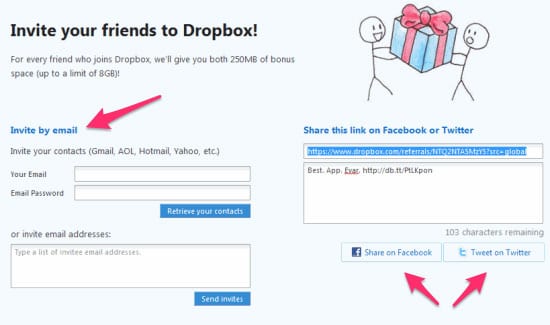
Viral Digital Marketing
Growth hacking is essentially building word of mouth on a digital platform. Word of mouth is how most businesses grow organically. If you are interested in Growth Hacking tactics for B2B companies then you need to be thinking about it in the context of referrals and word of mouth.
At this point, I would like to recommend two really useful books for any B2B Marketer looking into ways of scaling a SaaS technology business.
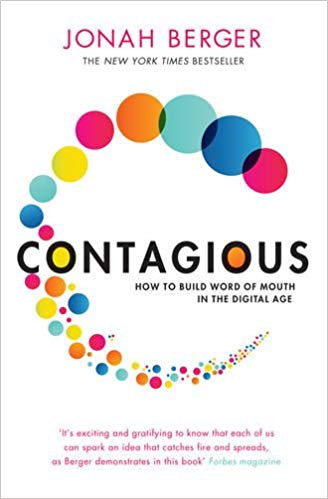
Contagious
By Jonah Berger
This book by Jonah Berger is super useful for B2B Marketers. It basically takes what Malcolm Gladwell wrote about in Tipping Point and added science into the factor. It also gives you a structure to work from too.
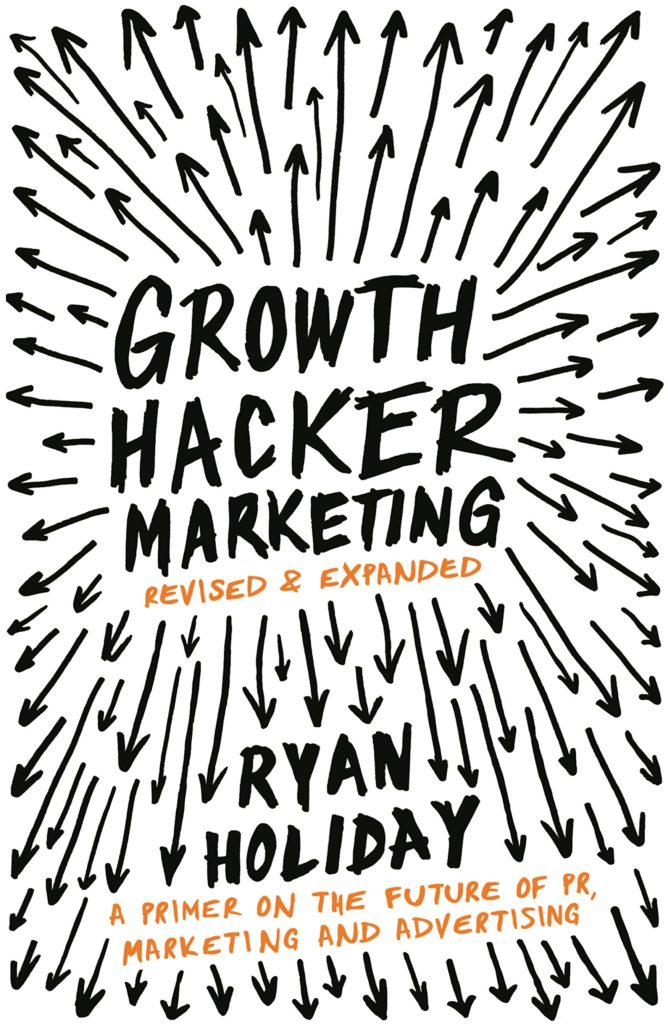
Growth Hacker Marketing
By Ryan Holiday
A short and concise book of examples and tips on growth hacking tactics. Some of which I have touched on in this article. A good quick engaging read for any SaaS marketer.
Summary
There are always lots of different ways/strategies of approaching B2B SaaS Marketing and technology marketing in general.
What I would say is first recognise the type of product you are working with. Is it truly a SaaS product or are you in-fact being told it is but, in reality, it requires installation and a sales introduction?
Questions you should be asking:
- Does it require someone to speak to a salesperson before they can use the product?
- Can you try it for free?
- Can it be used for personal use?
- Does it require customisation?
- Does it need someone to come and install it?
Whether you are a Growth Marketing Manager, Growth Hacker, Digital Marketing Manager or Marketing Manager. You need to recognise the type of product you are trying to grow.
From recognising the product you will then be able to focus on either more traditional B2B marketing strategies or get involved more in the product development and start to build growth into the product itself.
As a B2B marketer in a technology company, SaaS or not. You should be involved in the development and evolution of your companies product. You should be thinking of ways you can make the product more contagious and inspire word of mouth online.
More often than not, in B2B tech businesses the development team will make a product and then hand it over to marketing to “market”. This is an old fashioned and out-dated approach and doesn’t work for B2B SaaS Marketing and B2B Saas Lead Generation.
Traditional and hybrid B2B tech businesses need to both generate leads through the typical marketing channels by engaging in content marketing and SEO as well as thinking of ways you can have an impact on the product to help spread word of mouth amongst your current customers.
